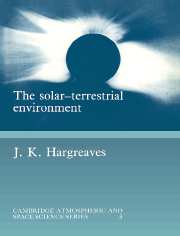 The Solar-Terrestrial Environment
The Solar-Terrestrial Environment Published online by Cambridge University Press: 29 January 2010
There is no excellent beauty that hath not some strangeness in the proportion.
Francis Bacon (1561–1626), Essay 43, Of BeautyThe geospace environment is complex and subtle. The concepts of the previous chapter lay down the basis of ionospheric behaviour, but in the real world additional factors conspire to complicate matters. To a large extent the ionosphere varies in a regular and predictable manner, but these regularities may not always accord with simple theory. In addition, major perturbations called storms occur from time to time, and the spatial structure includes irregularities of various sizes. Indeed, it appears that the structure of the ionosphere includes all the scales of space and time that are accessible to observation.
In this chapter we will first consider the regular behaviour of the ionosphere at middle and low latitudes, including ionospheric electric currents, and will then discuss perturbations and irregularities.
Observed behaviour of the mid-latitude ionosphere
We will begin with the regularities of the ionosphere – those variations with altitude, time of day, latitude, season, and solar cycle which are repeatable and therefore predictable (at least to an extent), and also with the ionosphere's response to solar flares and eclipses. All of these relate to the larger scales of variation: vertical distances measured in tens and hundreds of kilometres, horizontal distances in hundreds and thousands of kilometres, times in hours to years.
It should not be assumed, though, that because behaviour is regular it is necessarily understood. Historically, ionospheric observations were compared with the Chapman theory of the production of an ionospheric layer (Sections 6.2.2 and 6.2.4), and major departures from the theory were christened ‘anomalies’.
To save this book to your Kindle, first ensure [email protected] is added to your Approved Personal Document E-mail List under your Personal Document Settings on the Manage Your Content and Devices page of your Amazon account. Then enter the ‘name’ part of your Kindle email address below. Find out more about saving to your Kindle.
Note you can select to save to either the @free.kindle.com or @kindle.com variations. ‘@free.kindle.com’ emails are free but can only be saved to your device when it is connected to wi-fi. ‘@kindle.com’ emails can be delivered even when you are not connected to wi-fi, but note that service fees apply.
Find out more about the Kindle Personal Document Service.
To save content items to your account, please confirm that you agree to abide by our usage policies. If this is the first time you use this feature, you will be asked to authorise Cambridge Core to connect with your account. Find out more about saving content to Dropbox.
To save content items to your account, please confirm that you agree to abide by our usage policies. If this is the first time you use this feature, you will be asked to authorise Cambridge Core to connect with your account. Find out more about saving content to Google Drive.